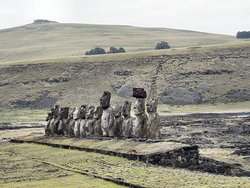Moai
|
|
Moai_Rano_raraku.jpg
Moai (pronounced MO-EYE) are stone statues on Easter Island. In most cases, the statues are monolithic, that is, carved from single stones, but some have additional, separate stone Pukau placed on the heads. The more than 600 known Moais are distributed around the entire island. Most of the moai were carved out of the rock at Rano Raraku, where nearly 400 more moai remain in various stages of completion. The quarry there seems to have been abandoned abruptly, with half-carved statues left in the rock. Practically all of the completed moai were subsequently toppled by native islanders in the period after construction ceased.
Although usually identified as "heads", many of the moai have shoulders, arms, and torsos, which have become buried over the years. The meaning of the moai is still unclear, and many theories surround these statues.
The most common theory is that the statues were carved by the Polynesian inhabitants of the islands 1000 or more years ago. They are thought to have been representations of deceased ancestors (as grave markers), or perhaps important living personages, as well as family status symbols. They must have been extremely expensive to craft; not only would the actual carving of each statue require years of effort, but they would then have to be hauled across the island to their final locations. It is not known exactly how the moai were moved, but the process almost certainly required wooden sledges and/or rollers.
Ancient island legends speak of a clan chief seeking a new home. The place he chose is now known to us as Easter Island. When he died, the island was divided up amongst his sons. Whenever a chief of one of these clans died, a moai was placed at the chiefs grave. The islanders believed that these statues would capture the chiefs "mana" (supernatural powers). They believed that by keeping the chiefs mana on the island, good things would come, rain would fall and crops would grow. This legend may be tainted from the original form because it was passed down over such a long period of time. Anything may have been added to this legend to "spice it up" and make it seem more interesting.
Sources
- Rediscovering Easter Island by Kathy Pelta, Copyright 2001 Lerner Publications Company, North Minneapolis, USA
- Ancient Mysteries by Rupert Matthews, Copyright 1988 Wayland Limited East Sussex, England
External links
- PBS NOVA: Secrets of Easter Island (http://www.pbs.org/wgbh/nova/easter/)
- PBS NOVA: Secrets of Lost Empires: Easter Island (http://www.pbs.org/wgbh/nova/lostempires/easter/)es:Moai


